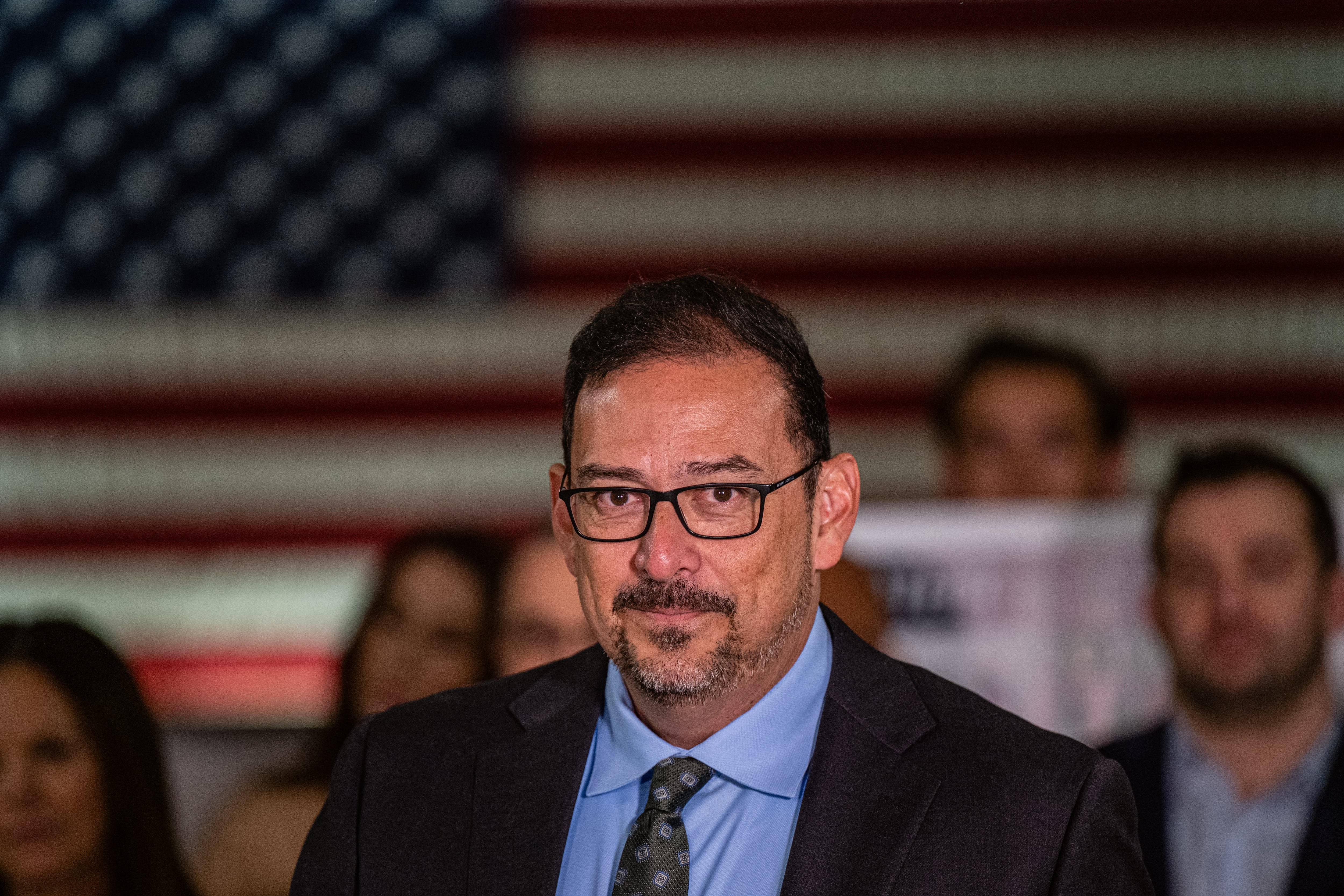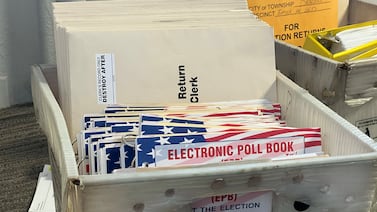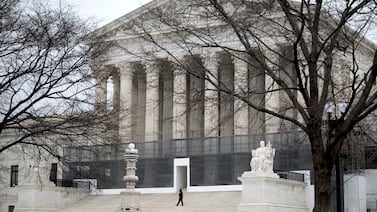Votebeat is a nonprofit news organization reporting on voting access and election administration across the U.S. Sign up for our free newsletters here.
Arizona Secretary of State Adrian Fontes is stripping down the giant rulebook that tells county officials how they must run elections in accordance with state law, a review of a partial draft shows.
While his draft is still unfinished, Fontes told Votebeat he wants the Elections Procedures Manual to include only the rules he believes county officials must legally follow, shortening the rulebook considerably as he removes what he describes as “opinion” from his predecessor, now-Gov. Katie Hobbs.
For her part, Hobbs previously refused to strip down the manual in this way herself during her time as secretary of state. As governor, she will ultimately need to approve Fontes’ version in order for it to go into effect.
In response to Fontes’ description of parts of the current manual as “opinion,” Hobbs’ office wrote in a statement that it was “drafted in close consultation with county officials, incorporated feedback from the public,” and has withstood multiple legal challenges.
“It was a critical part of what allowed Arizona to administer successful, secure, and accurate elections in the 2020 and 2022 election cycles, despite the unprecedented challenges election officials confronted,” the office wrote.
The partial first draft of the manual, which hasn’t yet been released for public comment, is on track to be dozens of pages shorter than the 273-page version currently in effect, according to a Votebeat review of 11 chapters that have so far been submitted to counties for feedback. The few remaining chapters will be sent to counties next month.
It would give local county election officials more leeway to decide how to implement some aspects of state law. County recorders would no longer be told how exactly to compare voter signatures when deciding which mail-in ballots to accept, for example. Elections directors would no longer be reminded that some people in jail can still vote and given guidelines for how best to ensure that can happen. And, so far, there are no instructions at all in the manual regarding how voting equipment must be certified or how candidate nominations must be processed.
Fontes said that, with new elections directors or recorders in 11 of 15 counties, he wanted the manual to be “as efficient and user-friendly” as possible. That way, he said, it would be completely clear what election officials are required to do under state law, and he plans to issue any other guidance or best practices separately.
“So they wouldn’t have to second-guess – does this piece have the force and effect of law, or is it just an opinion,” Fontes said.
Fontes is still getting feedback from counties and revising his draft, which should be released for public review in August.
State law requires the secretary of state’s office to send the manual to the governor and attorney general by October, and for the governor and attorney general to approve it by the end of the year, with any revisions complete by then.
This process has been fraught in recent years because of infighting between parties. And even though all the top state officials involved are now Democrats, that doesn’t mean it will go smoothly: Hobbs and Fontes must resolve their different philosophies on what the manual should include.
In 2021, during the review process, former Attorney General Mark Brnovich, a Republican, asked Hobbs to make the same types of cuts to the manual that Fontes is making now. Brnovich cited a recent state Supreme Court ruling, McKenna v. Soto, that found that because the topic of candidate nominations wasn’t mentioned in the section of state law giving the secretary of state rulemaking authority via the manual, it didn’t have the force of law. That ruling conceivably sets the stage for any other topics in the manual that aren’t specifically mentioned in that section of state law to be challenged in court.
Because Hobbs would not edit the manual as Brnovich requested, the 2021 version never took effect. Fontes, on the other hand, has cut much of what Brnovich had requested.
It’s unclear whether or how Hobbs will protest Fontes’ changes. The governor’s office says it has offered to discuss anything with Fontes as he writes the initial draft, but won’t provide edits until the secretary officially submits it to them in October, according to Hobbs’ spokesperson Sophia Solis.
“We look forward to working with them further on the EPM this fall,” Solis said.
While county officials have mostly provided supportive feedback so far, voter advocacy groups who have begun to review the draft chapters as a coalition are concerned by some of the cuts.
Alex Gulotta, the Arizona director of All Voting is Local, said the advocates’ coalition is concerned that the revisions “will remove key guidance for counties that protect thousands of voters every election.”
Fontes changes “shall” to “may”
The manual provides specifics for how election officials must meet the requirements in state election law. Often that has meant adding rules on top of rules.
For example, state law requires recorders to consult a voter’s record when trying to determine if the signature on their mail-in ballot envelope is valid. The current manual tells the recorders that they must look at not just the original signature on the voter registration form, but also signatures on other documents such as early ballot request forms and signature rosters.
Fontes’ draft takes that language out.
Fontes said the starting point for his draft was the 2014 manual – not Hobbs’ 2019 version or her 2021 draft — because he felt chunks of the more recent versions were guidance, not law.
Fontes was Maricopa County’s recorder from 2016 to 2020, so he comes at this with the perspective of a county official who was required to follow the manual both before Hobbs’ changes, and after.
With the recent Supreme Court ruling in mind, Fontes has removed sections and lines that he believes either surpassed his rulemaking authority and therefore didn’t really have the force of law, unnecessarily repeated rules already in state law, or could be seen as conflicting with state law. Fontes also cuts an entire chapter on candidate nominations, along with a 10-page section on voting equipment certification. Some other chapters are cut by as much as a third.
Tom Collins, executive director of the Arizona Citizens Clean Elections Commission, said he understands Fontes’ approach. After McKenna, he said, it makes sense to be able to point to specific sections in election law that the manual is operating under the authority of, while also trying to provide uniformity for how counties conduct elections.
In many areas, Fontes changes instructions from “shall” to “may,” or “must” to “should,” essentially removing a rule county officials had previously been required to follow. Voting advocates believe that will lead to weaker and less uniform voting access around the state.
For example, a requirement that the county recorder “shall establish” on-site early voting at the county recorder’s office during early voting now says “may establish.” And, in Fontes’ draft, election directors “may” consider redrawing precincts to reduce the likelihood of excessive wait times, instead of “must,” as it reads now.
Voter advocacy groups had pushed Hobbs to use the 2019 manual to explain to election officials that voters in pretrial detention or serving time in jail for a misdemeanor remain eligible to vote, and to outline how to ensure those voters could exercise that right. That section, too, is gone from Fontes’ current draft.
“If those sections were challenged in court, I don’t know how effectively we would be able to defend them,” Fontes said.
Fontes points out that Arizona’s 15 counties vary greatly in size, resources, equipment, and capabilities, and said he believes the changes to the manual will help them. Pima County Recorder Gabriella Cazares-Kelly said that she and others were initially worried about Fontes’ approach, but she now sees it could provide needed flexibility for counties.
She said she has “high hopes” that Fontes will be able to provide additional guidance for counties separately from the manual.
Fontes adds to protect against future challenges
There are some areas where Fontes has added his own rules —including in response to the threats to election workers and voters that came up across the state in 2022 and may again in 2024.
For example, after groups staked out ballot drop boxes, taking photos of voters and confronting them, Fontes is adding to a section on voter and poll worker intimidation. Intimidation, according to the draft, would include photographing and videotaping voters, as well as following them to their cars.
“We are in a different space, and I can’t ignore that,” Fontes said. “I want our voters to have intimidation-free access.”
This change, and others, are likely to prompt pushback from GOP activists and lawyers.
In 2021, Brnovich asked Hobbs to remove the entire section on voter intimidation, saying it was outside the scope of the manual.
Jen Wright, who was assistant attorney general under Brnovich and reviewed some of Fontes’ proposed changes, said the manual was not designed to ask election officials to enforce criminal laws or create a definition for voter intimidation that isn’t in the law, and argued there are constitutional issues with the new rules.
“The EPM cannot create new criminal laws that are expected to be enforced by law enforcement or poll workers,” she said.
In another change, Fontes is adding a broad line that says any election in Arizona must provide opportunities for no-excuse early voting by mail and in-person. This comes after a failed lawsuit from the state GOP claiming mail-in voting was illegal. But Wright said nothing in statute mandates in-person early voting for every election.
In a future chapter, Fontes could choose to specify that electronic equipment must be used to count ballots – something that is currently under debate across the state as multiple counties study hand-counting ballots.
Ballot drop boxes have increased in popularity, and he is including a line mandating they be in locations accessible to voters with disabilities.
Fontes is also adding in a requirement that says, when sending mail-in ballots out, county officials must provide instructions to the voter for how to make it clear on their ballot who they intended to vote for in case they make a mistake on their ballot.
Maricopa County elections director Rey Valenzuela believes that line might conflict with a recent court ruling involving Fontes when he was a recorder, according to initial feedback the county provided to Fontes’ office. The Arizona Supreme Court found that Fontes did not have the authority to provide those instructions as county recorder.
Fontes said he tried to stay true to what law allows when drafting the manual, considering not what he believed should be in there, but what legally could be in there.
“I have to be cognizant of not just what I want to see in there, but what the consequences are two, and three and four steps down the road,” Fontes said.
Collins said that, with the increase in election litigation, it makes sense to take a textualized reading of the law regarding the manual’s powers.
“It’s foreseeable that someone is going to litigate every page in that book,” he said.
Jen Fifield is a reporter for Votebeat based in Arizona. Contact Jen at jfifield@votebeat.org.






